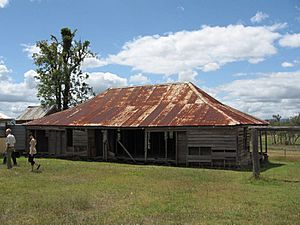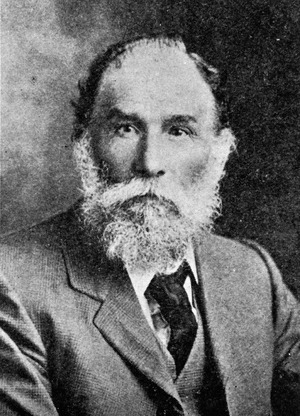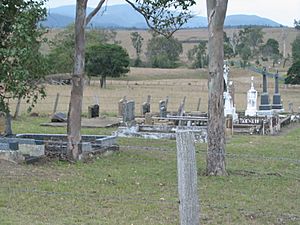Castleholme Homestead facts for kids
Quick facts for kids Castleholme Homestead |
|
|---|---|

Castleholme Homestead, 1979
|
|
| Location | Bryden - Crossdale Road, Bryden, Somerset Region, Queensland, Australia |
| Design period | 1870s - 1890s (late 19th century) |
| Built | c. 1875 - 1950s |
| Official name: Castleholme Homestead, Conroy's Farm | |
| Type | state heritage (built, landscape) |
| Designated | 21 October 1992 |
| Reference no. | 600491 |
| Significant period | 1870s-1890s (historical) 1870s-1890s (fabric) |
| Significant components | residential accommodation - workers' quarters, shed - hay, out building/s, stables, shed/s, fencing, barn, cow bails, yards - livestock, residential accommodation - main house |
| Lua error in Module:Location_map at line 420: attempt to index field 'wikibase' (a nil value). | |
Castleholme Homestead is a special old farm property located on Bryden-Crossdale Road in Bryden, Queensland, Australia. It's known as a "heritage-listed" site, which means it's important to history and protected. The homestead was built over many years, starting around 1875 and continuing into the 1950s. It is also sometimes called Conroy's Farm. This historic place was added to the Queensland Heritage Register on October 21, 1992, recognizing its value.
Contents
A Look Back in Time at Castleholme
Castleholme Homestead began its story in the 1870s. A man named Hugh Conroy chose and bought this land in 1875. Back then, it was about 257 hectares (or 635 acres) in size.
By 1916, the small cedar house at Castleholme had grown a lot. It became a large, sprawling house with fourteen rooms and wide verandahs. The property also had beautiful flowerbeds, shrubs, and shady trees. There were many important farm buildings too. The main activity on the farm was dairying, which means raising cows for milk.
The Conroy family owned Castleholme for a very long time. They kept it in their family until 1978. After that, the land became part of the area for the Wivenhoe Dam.
What You Can See Today at Castleholme
Today, Castleholme shows us what's left of an old homestead. You can still see parts of the main house, a slab barn, a small cottage, and stables. There are also other farm buildings and places where livestock were kept. Many old, tall trees still stand on the property.
Castleholme is located in the Brisbane Valley. It sits on a slope that faces northeast. You can see it clearly from the Bryden-Crossdale Road. The property is also right next to the Bryden Catholic Cemetery.
The main house and other living areas are grouped together towards the north. The farm buildings are more towards the south. You can also find the remains of a timber laundry shed and a bakehouse. There are old post and rail fences, a calf pen, and cow milking stalls (called cow bails).
Why Castleholme Homestead is Important
Castleholme Homestead was added to the Queensland Heritage Register because it meets several important rules. These rules show why the place is special and worth protecting.
Showing Queensland's History
Castleholme is important because it helps us understand how the Bryden area grew. It shows how dairying became a big part of the local economy. The homestead is also strongly connected to the Conroy family, who played a key role in the area's history.
Learning from the Past
This place can teach us a lot about how dairy farms were set up in the late 1800s. By studying the ground and what's left, we can learn about the layout of the farm.
A Great Example of a Farm
Castleholme is a good example of a working farm in southeast Queensland. It shows how farms changed over more than a hundred years. You can see how the buildings, technology, and materials used on the farm evolved over time.
Beautiful and Special
The group of timber buildings and the surrounding grounds at Castleholme have a special beauty. The way they are arranged is pleasing to look at. It's also important because it's located right next to the St Anne's graveyard.
Connected to Important People and Places
Castleholme has a special link to the nearby St Anne's graveyard. This connection makes it even more historically significant.



